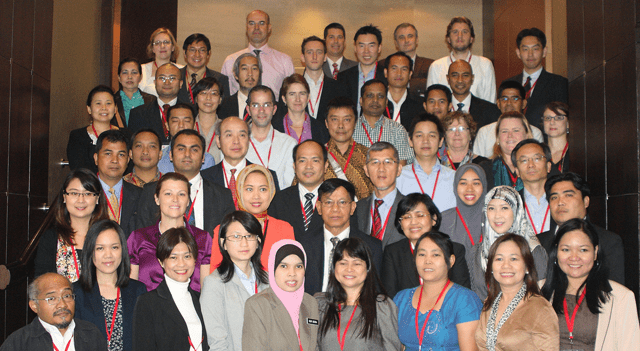Association of Southeast Asian Nations (ASEAN) organizes capacity building forum on risk assessment to improve disaster management.
In Bangkok, March 19-22, the ASEAN Capacity Building Forum on Risk Assessment brought together national disaster management office (NMDO) representatives from the Member States as well as leadership from the ASEAN Secretariat and the Coordinating Centre for Humanitarian Assistance (AHA Centre). The forum was held with the aim of advancing disaster risk assessment, which was indicated as one of the key areas for successful disaster risk management by the United Nation’s 2011 Global Assessment Report (GAR) and is one of the Association’s flagship projects through 2015 under the ASEAN Agreement on Disaster Management and Emergency Response (AADMER).
Creating policy, plans, and regulations for effective disaster risk assessment means bridging the gap between scientists, disaster risk management professionals, and policy makers—groups that often do not directly interact, and typically operate under very different paradigms. Thus, the forum brought together various risk reduction and risk assessment stakeholders including disaster management agencies, nongovernmental organizations, and academic and research institutions to explore how these groups can more effectively leverage one another’s knowledge and programs for enhancing risk assessment capacity in the ASEAN region.
Pacific Disaster Center (PDC) has been a dialog partner working with ASEAN on cross-sectoral disaster risk reduction projects for nearly a decade. Over the years, PDC has contributed to AADMER and many information technology (IT)-related initiatives including the Disaster Information Sharing and Communications Network (DISCNet). PDC was invited to share its experiences in linking the science and technology (S&T) community with decision makers for effective outcomes. At the forum, PDC Deputy Executive Director, Chris Chiesa, presented on broad-based stakeholder engagement throughout the entire project, from inception through the implementation process, and how that helps the different sectors and groups align to improve disaster management. Chiesa underlined the relationship saying, “It is a true pleasure to be able to work with ASEAN and its Committee on Disaster Management (ACDM) and AHA Centre. Together we have demonstrated meaningful applications of science and technology to build resilient communities and institutions in the region.” PDC’s most recent contributions include the deployment of the regional Disaster Monitoring Response System (DMRS) at the AHA Centre and the single-nation VinAWARE application for Vietnam, both of which are built upon its DisasterAWARE multi-hazard decision support platform.
Ms. Adelina Kamal, Head of the Disaster Management and Humanitarian Assistance Division of the ASEAN, and Mr. Said Faisal, AHA Centre Executive Director, also emphasized the value and importance of long-standing relationships, pointing to the development of AADMER and DMRS.
The Forum was organized by the ASEAN ACDM. Other notable agencies represented include the United Nations Office for Disaster Risk Reduction (UNISDR), World Food Program (WFP), United Nations Economic and Social Commission for Asia and the Pacific (ESCAP), European Commission Humanitarian Aid and Civil Protection Organization (ECHO), Japan International Cooperation Agency (JICA), Australia Aid (AusAID), Australia-Indonesia Facility for Disaster Reduction (AIFDR), Save the Children, and various universities from within Asia and the U.K.
Additional information about ASEAN, the AHA Centre, and AADMER:
• On the ASEAN website.
• On the AHA Centre website.
• On the AADMER Partnership Group website.
Additional information about DMRS:
• Article about the 2013 deployment of DMRS.
• Article about DMRS activity in 2012.
• About an ICT Workshop at the AHA Centre.
• About DISCNet.
• On the Online Southeast Asia Disaster Inventory (OSADI) portal.
• On the Online Southeast Asia Disaster Map (OSA-Map) portal.

